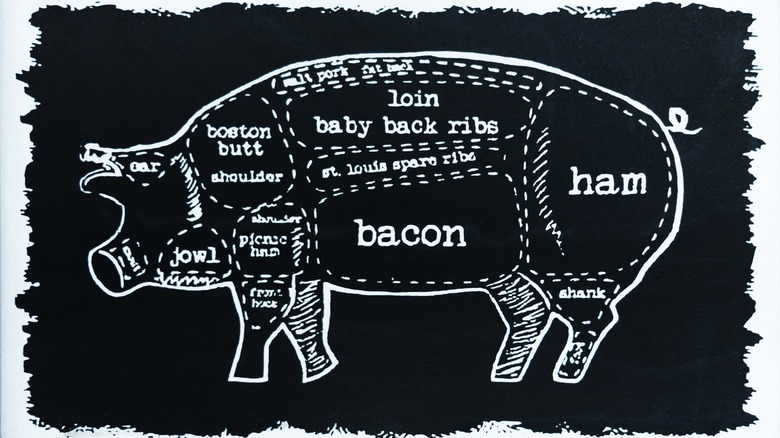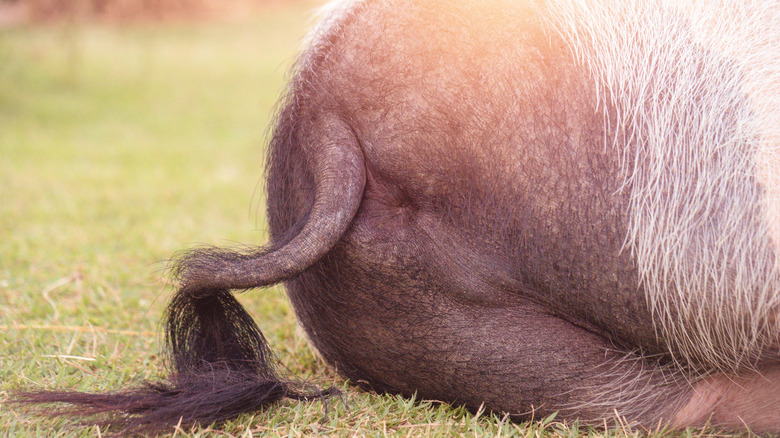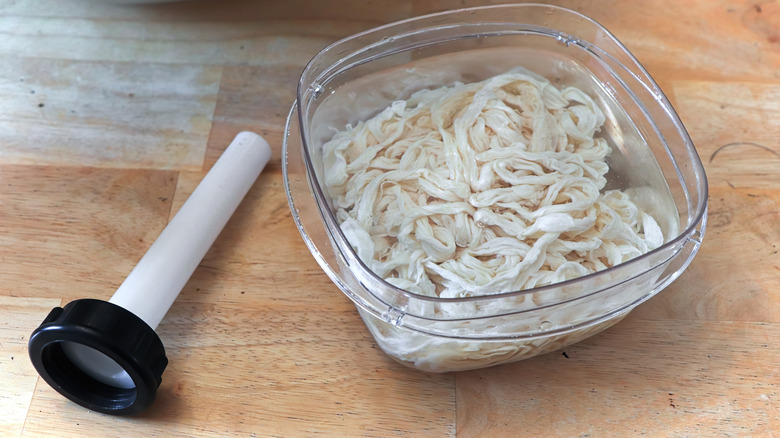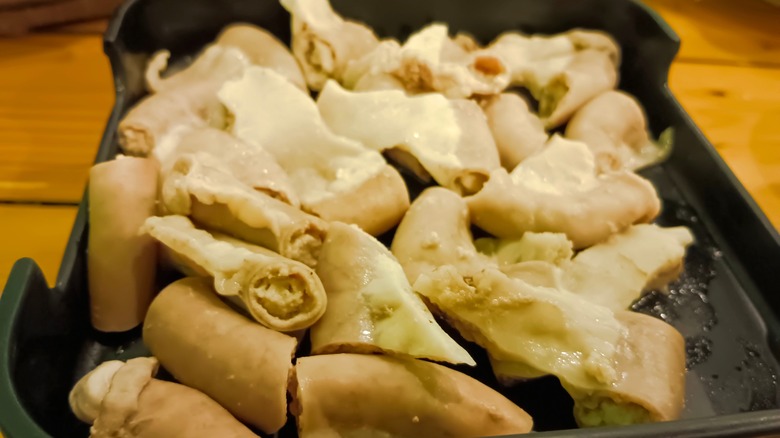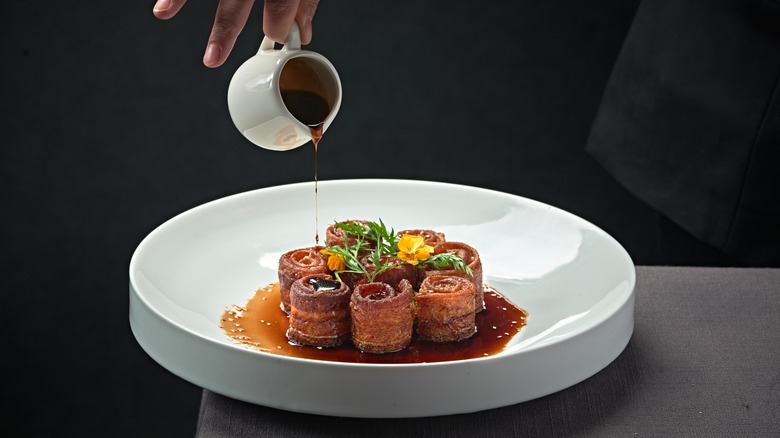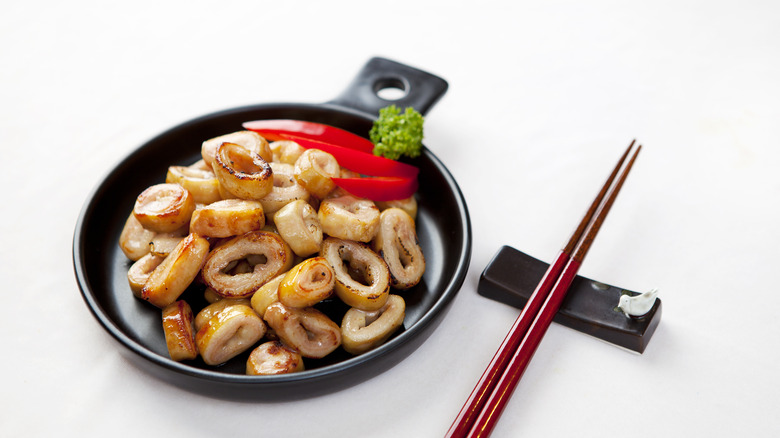What Exactly Is Pork Bung And How Do You Eat It?
Let's start this off by saying that your answer to the question in the headline is likely right on the money. Pork bung isn't a nice pale pink piece of pork meat that you'll find wrapped in cellophane at the store. Pork bung (probably) isn't going to be glazed in a reduction of sherry and shallots and served with pommes aligot at a fabulous little bistro you know. Pork bung is, in fact, the final length of the hog's digestive tract, its rectum.
Bung is a term that is more often associated with wine. Specifically, it is the stopper hammered into the bunghole on the side of a wine barrel. As this is the hole through which the wine barrel is drained, it rather poetically became associated with other holes used for emptying. Pork bung, however off-putting its provenance may be, is eaten and enjoyed the world over much like other bits of animal offal. And, though you may have already decided you'll never sink your teeth into pork bung, you may have come a lot closer than you think.
Is pork bung safe to eat?
That pork bung comes from a hog's rectum is established, but what is the rectum exactly? Well, in mammals, it is the last portion of the digestive tract where feces is stored before being expelled. The rectum is not inclusive of the anus, which is the exterior portion and terminus of the digestive tract. Or, as some may prefer to think of it, pork bung is what it is.
You'd not be remiss if you were wondering how something so intrinsically tied to feces and defecation can be safe for human consumption. The same as anything else: through thorough cleaning. Once separated from the hog, the pork bung must be washed several times in clean water until you're certain that it no longer harbors feces. Then it is to be soaked in a tub of vinegar diluted with water for an hour before being boiled in clean water for 10 minutes to sanitize it. Once this thorough process is complete, you can move on to cooking your pork bung.
Another thing to remember is that, ultimately, pork bung is an organ meat, also known as offal. Moreover, it is one of the organs involved in the excretory and digestive processes, and tastes as such. What does that mean? Pork bung possesses the gamey character of offal as well as the slight ammonia tinge of organs like kidneys.
Pork bung vs. sausage casings vs. chitterlings
Still convinced you'd never touch pork bung, not even a small part of it? Well, if you eat meat there's a very good chance you already have. Natural pork casings used to make sausages are derived from the hog's small intestine, but only a part of it. To make casings, all but the submucosa is removed. The submucosa is rich in collagen, a connective tissue, which makes it strong enough to stuff and withstand cooking, yet still be tender enough to bite through, producing the signature "snap." Hot dogs that feature a natural casing typically use sheep intestinal submucosa which is smaller in diameter.
Pork bung is different here in a few key ways. First, it's not just one layer of the digestive tract, but a whole portion of it, including the mucous membrane and the muscles that power digestion. Second, the submucosa comes from the small intestine, while the pork bung, being the rectum, is part of the final stage of the hog's large intestine.
Speaking of things pork bung isn't, chitterlings (or chitlins) are one of them. This dish, commonly enjoyed throughout the American south and an important part of African American culinary history in the U.S., is very similar to pork bung, but, like sausage casings, is made from the small intestine of the hog. That said, the cooking processes for the two cuts of offal are very similar, which further adds to confusion.
How do you cook pork bung?
Once your pork bung is cleaned and properly boiled, how are you to prepare it? As mentioned, it is eaten the world over, so there are multitudes of options. The most basic way to cook pork bung, and a method many recipes employ before further cooking, is to braise it in water, stock, or another liquid for an hour or two to tenderize the strong muscles and connective tissues of the cut. This is also where you might throw in aromatics ranging from mirepoix and thyme to ginger, soy sauce, and star anise, depending on what route you are going with the meal as a whole.
After the braising is done, the pork bung should be tender, but still slightly toothsome and still tasting richly of the offal that it is. The fatty tube can then be sliced however you like; thin rings, thick biased cuts, etc. It can also be served straight away over noodles or in a tortilla, or just eaten plainly with a simple sauce for dipping.
Filipino pork bung recipes
If you've made it this far, it's either out of brazen curiosity or genuine interest in seeing what more can be done with pork bung. For those still a bit squeamish, consider the Filipino-style preparation of this dish. The American palate is generally not geared for foods that are overly chewy, slippery, or springy in texture, but we do love crunchy and crispy foods.
Enter crispy bagbagis, or deep-fried pork intestine, a dish that still requires braising the pork bung in several changes of salted water, but then sees it sliced into thick rounds and plunged into hot oil. The result is crunchy on the outside, slightly chewy on the inside, all-around rich nuggets of pork offal flavor. This snack is not trying to be anything fancy. Serve this with a bit of Filipino spicy vinegar to cut through the fat and a cold beer to wash it all down.
If you're more a fan of the grill than the deep-fryer, turn to Inihaw Na Isaw Ng Baboy, aka barbecue pork intestine, another Filipino recipe. Again, the braise is much the same as above, but instead of a hot oil bath, the pork bung is threaded onto bamboo skewers and grilled. Before hitting the grill, the skewers get rubbed with black pepper, salt, cumin, garlic powder, and cayenne. During their time over the coals, they get brushed with a mixture of banana ketchup, sugar, and vinegar.
Pork bung stir-fry
Maybe it's the idea of eating pork bung by itself, or rather the texture, that has you a bit unnerved. That's understandable; popping a slice of nothing but pork bung in your mouth means you're getting the full experience. The best thing to do here is to incorporate pork bung into a larger dish so that it is contributing its essence without stealing the show.
Pork bung makes a great addition to a Szechuan stir-fry, where the bold flavors of the cuisine stand their own next to a strong offal. A classic recipe would call for first braising the pork bung and slicing it, then cooking it quickly in a screaming hot wok with onions, bell pepper, chilis, Szechuan pickled mustard greens, garlic, ginger, soy sauce, and rice wine. If you need to further enhance your stir-fried pork bung, you can hit it with a squeeze of sriracha, pour on a tangy dollop of sambal oelek, or sprinkle it with vinegar for a bit of balance.
Where to buy pork bung
You're probably now clamoring for pork bung, yet it's nowhere to be found at your regular markets. One of the ancillary benefits of seeking out offal and other cuts that are unusual to Americans but commonplace in other cultures, like chicken feet, is that you get to step outside your comfort zone. The big box grocery store down the street doesn't have pork bung, so use this as a chance to visit a grocer that caters to the cuisines of other cultures. Pan-Asian grocery stores and those that serve more specific nationalities, such as Mexican supermarkets, Korean grocers, and Chinese food markets, often have an array of cuts that fall outside western butchers' purview. If you can't find it in the meat section or in the freezer, don't hesitate to ask the butcher if they can make it available for you.
If you don't live in an area with ready access to a market like this, then ask your local butcher if it can be ordered. And if even that turns out to be a dead end, then there's always the expansive availability of the internet to fall back on. A simple search turns up a variety of outlets that sell and ship frozen pork bung nationally.
